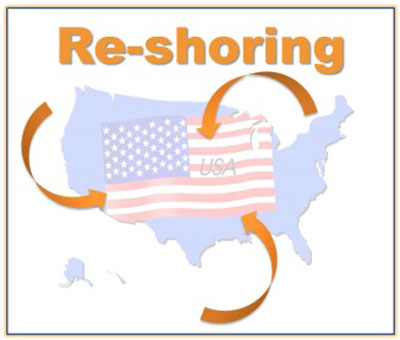
GE has started to rev up Appliance Park again – and is starting to bring manufacturing back to the U.S. A few of my key contacts and clients have asked about re-shoring. The buzz in the news is beginning to focus on re-shoring. Add it all up – re-shoring to North America is definitely on the rise. Are you positioned to leverage this new trend? First, it makes sense to think through WHY we’d be thinking of re-shoring. There are several key points to consider: 1) Service & quality. 2) Speed & flexibility. 3) Cash. 4) Total Cost. 5) Risk.
- Service & quality: In today’s new normal business environment, there is little that is more important than service. For example, I have several client examples where if they can deliver 5% faster than their competition (reliably of course), they will gain the business – even if their pricing is a little higher (and in some cases, significantly higher).There are a multitude of issues that can arise which will negatively impact the customer with outsourced product. A laundry list of items that pop to mind include: a large customer of the outsourced supplier has an emergency that delays your shipment; since you are shipping in bulk, you have to wait for a large enough production run (or combine orders) to fill a container; issues at the port overseas; political unrest; port strikes; natural disasters impacting shipment; delays at customs; etc.Additionally, as customers’ expectations rise, they not only expect improved service levels but they also ASSUME high quality levels. Although outsourced product quality can be managed, “Made in the USA” has a positive quality image and is more within manufacturers’ control – and within a quicker timeline.
- Speed & Flexibility: Speed is king in the new normal. Although this also relates to service levels, it is a critical enough topic to stand on its own. Speed can translate into delivery speed, product development speed, innovation speed, issue resolution speed, speed to replace parts or address expedite requests, etc. Clearly, North America will have an advantage with speed!
- Cash: Cash flow remains critical in the new normal. Although companies have more cash now than they did during the recession, there is a heightened level of volatility in today’s environment which requires an increased level of cash reserves. Additionally, I’ve yet to meet an executive who wanted more inventory tied up in cash than is required to successfully manage the business. The longer the lead times and transportation time frames and the greater level of customer order volatility, the greater the need for inventory. Thus, producing closer to your customer is desirable. For North American customers, producing in North America requires less inventory.
- Total Cost: Cost and specifically the vast difference in wage rates is the reason why outsourcing gained such steam for many years; however, wage rates in China have risen dramatically in the last few years (and is projected to continue rising). If labor is not a significant percentage of product cost, outsourcing is less likely to be a cost advantage. The other key cost is transportation cost. If product is bulky or heavy, outsourcing is less likely to have a cost advantage. Last but not least, when you add in the remaining total cost factors such as IP cost, travel costs, etc., the outsourcing cost advantage is murky at best.
- Risk: The need to manage and mitigate risk continues to increase. In addition to service risk (inclusive of the laundry list referred to under potential service impacts), executives must consider supply chain risk, IP risk, security risk, etc.
If you haven’t taken a step back to re-evaluate outsourcing and re-shoring, it is an opportune time to do so. Those companies that notice key trends and find opportunities to leverage them will thrive – and surpass their competition along the way.


